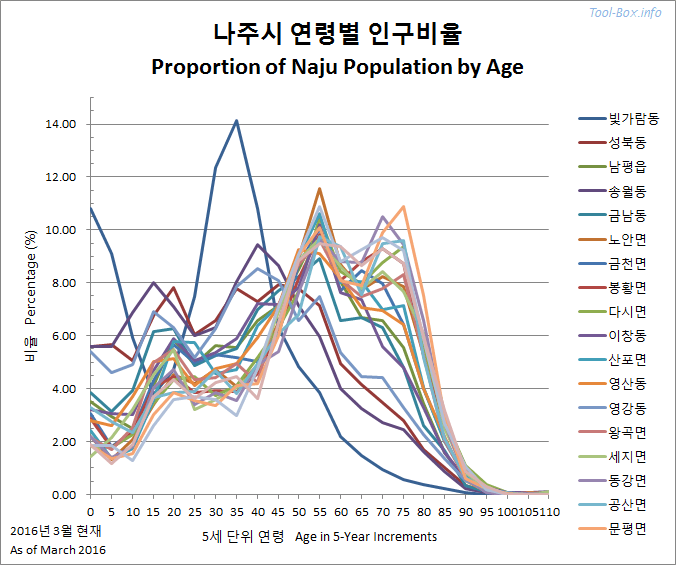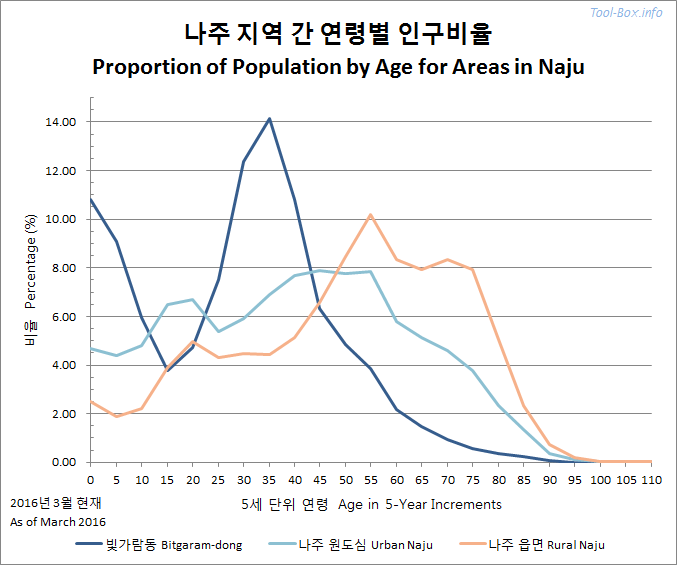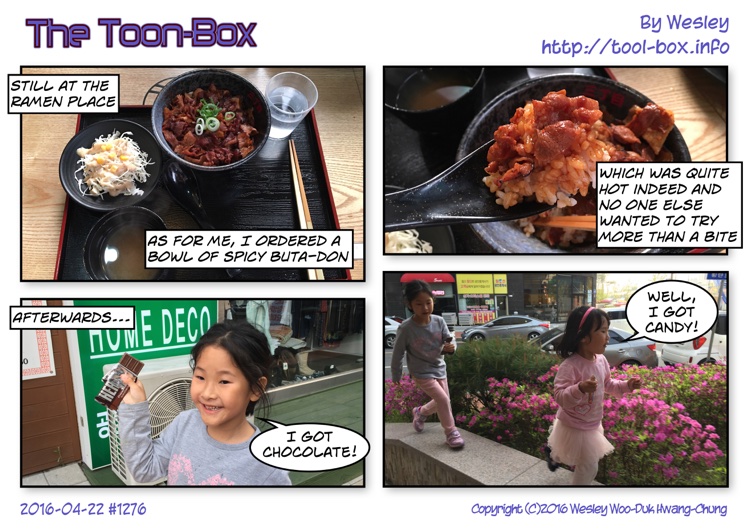Naju population returns to 100 thousand - who's in there?
Posted by Wesley on
Proportion of Naju Population by Age
Naju City Hall has announced this morning that the city's population has officially rebounded to 100,000 as of yesterday, April 21, 2016, which is something I've been expecting earlier this month. Bitgaram Innovation City (Bitgaram-dong) has been credited with this turnaround, with the district itself reaching the population of 15,000 on April 15.
This is great and all, but I now wondered what sort of people make up the entire city. An easy way to see this is to see the population in terms of proportion by age group. The graph above shows this for each of the districts of the city, starting with the Bitgaram-dong at the top. Already, you can see that Bitgaram-dong stands as a complete outlier to the rest of the city. There are also two other separate patterns, one for the urban districts (other "dong") and the other for the rural districts ("eup" and "myeon"). To make this clearer, I grouped these in the graph below.

Proportion of Population by Age for Areas in Naju
The rural districts that have about half the total population (50,138 as of March 2016) show significant aging, as expected. Much of the population peak around 50s and 70s, a typical trait of a rural town. The relatively younger generation, between mid-30s to mid-50s, tend to live in the urban districts that form the original downtown (population: 34,772), where employment opportunities and available amenities tend to be better. However, the dip in population between late 20s to early 30s suggest that the people who graduated universities and colleges went out to other towns for employment. Naju was sorely needing places for jobs.
This is where Bitgaram-dong came in. Essentially rooting 16 (2 pending) public corporations out of the Seoul metropolitan area and transplanting them into a new city created out of the bulldozed pear orchards and rice paddies, it aimed to revitalize the slowly dissipating Naju. Looking at the graph, it's clear that the employees who weren't too old or have children in the higher education tended to move in with their entire families, so you see two very strong peaks in the 30s and preteens. Considering future growth, Naju's overall population mix will shift significantly younger thanks to this.
Here's my thoughts on looking at all this. The influx of young people into the town leads the growth of the commercial sector, hopefully creating a virtuous cycle of new jobs and further population growth. The greed of the building owners need to loosen up, though. I already hear that the rent is too high. That's going to hurt everybody. One must remember that the metropolitan city of Gwangju has pretty much everything and it's only 20 minutes' drive away.
Meanwhile, the disproportionately large share of the preteens leave quite a bit of work for the civil servants, specifically in terms of education. The demand for nurseries, kindergartens, and elementary schools is at a record high and the city hall / office of education are having a hard time coping with it in a timely manner. But meeting these demands is going to be a big factor in maintaining the growth. After all, Koreans are very conscious, nay, obsessive in providing good education to their children. If the families get disappointed, they might as well move out, again likely to Gwangju. Let's hope that the authorities get their acts together and not let this happen. Naju has bleeded because of Gwangju long enough.
